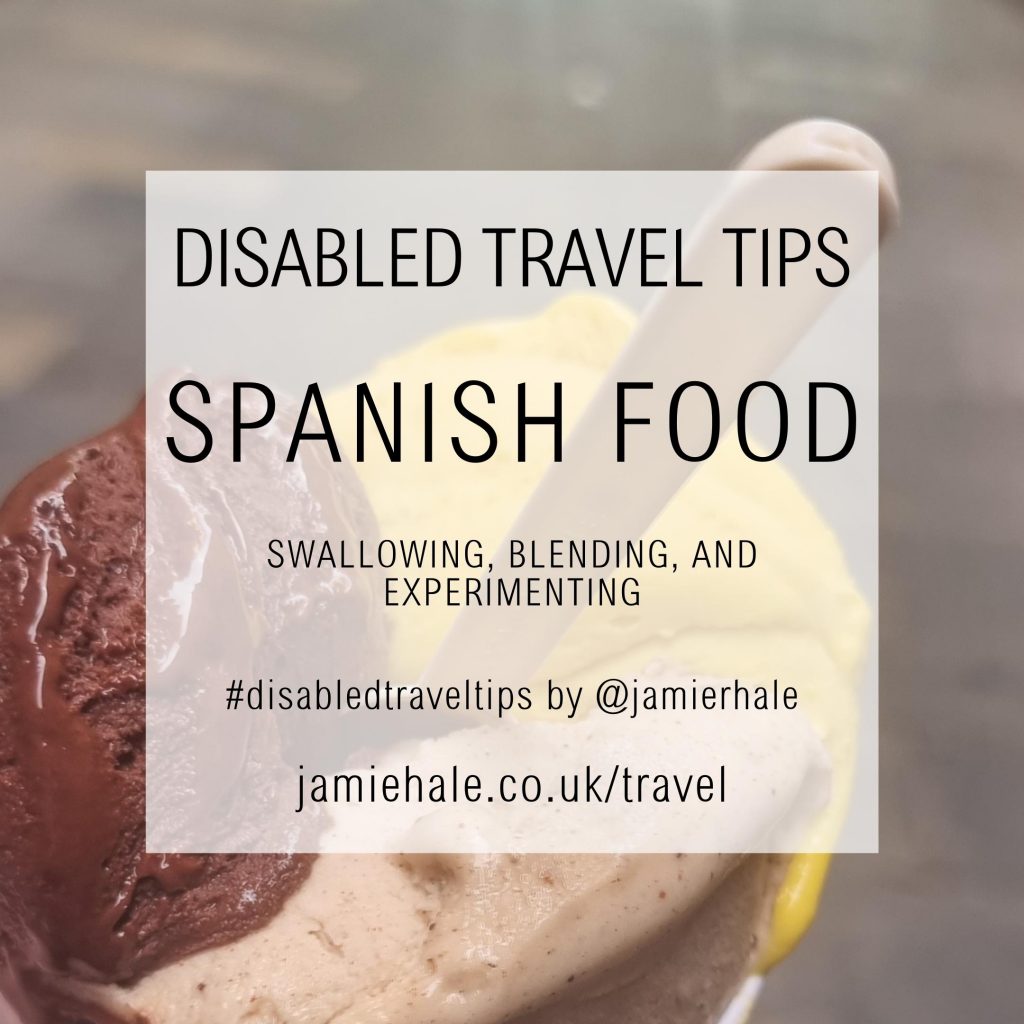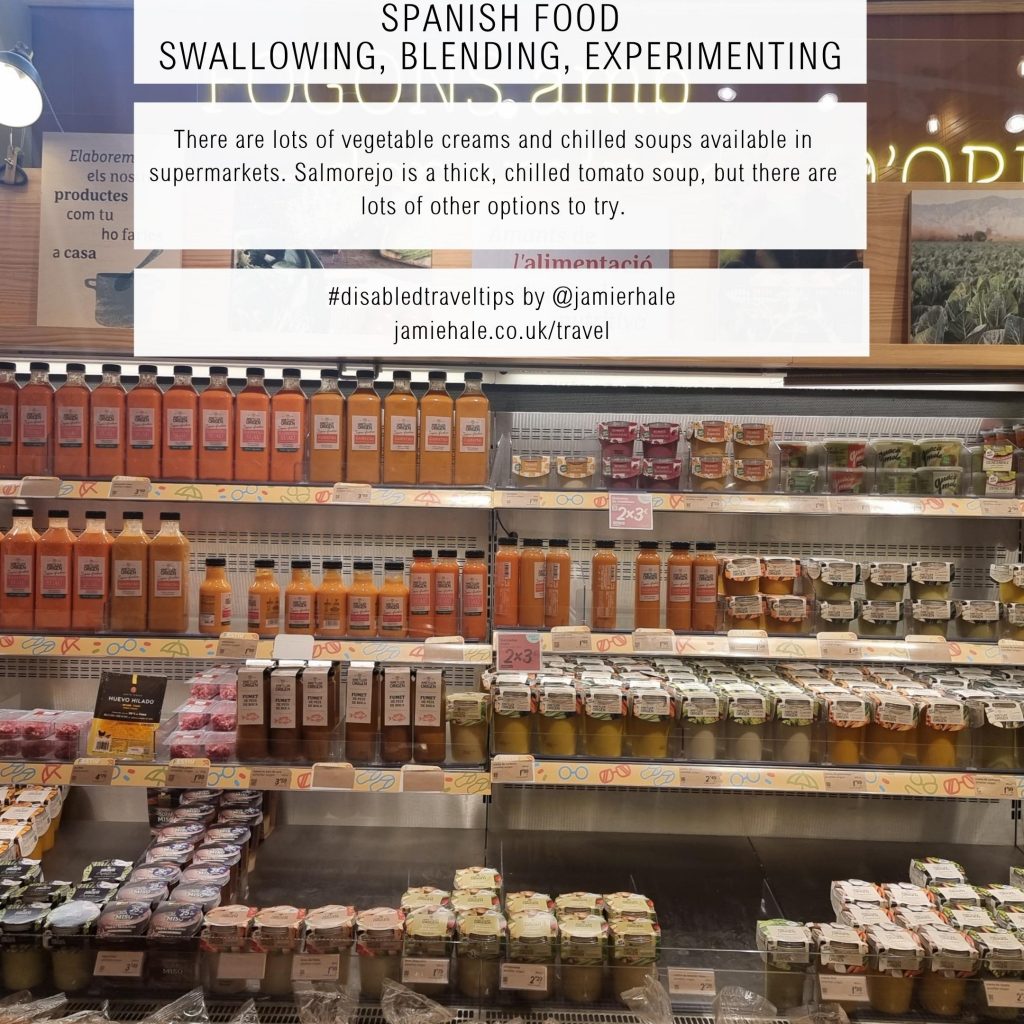If you’re on a restricted diet, working out what you can eat or drink abroad can be really challenging. Whilst you can add thickeners to most liquids, it’s nice to be able to take part in the Spanish food and drink culture. That relies on knowing what’s safe to have, and while you need to make your own judgements, hopefully this can guide you.
As I wandered Barcelona, I noticed that there were quite a few things that struck me as being reasonably easily to swallow or adjust for people reliant on soft, modified, or blended diets. Since I was writing a series of reviews and tips on Barcelona anyway, I decided to write a bit about the food and drink options – but please note that this is not my situation, so the tips don’t come from personal experience






I am not a medical professional, and I can’t guarantee whether any of these suggestions would be suitable for you. If you’re eating food, adjusted or not, make sure you’re careful to follow what your body is safe to do. However, you can probably do a lot to make the local food culture accessible for you.
If you’re someone who uses a lot of blended food, carrying a portable blender will make it easier for you to adjust food at the table. This allows you to sit at a restaurant and eat some of the same meals as other people. However, whether you’re blending things or not, there are lots of Spanish dishes to consider.
Visiting supermarkets
If you’re looking for food in supermarkets, there are lots of pureed vegetable creams available. These are almost like a thick soup you might find in England. However, they have often (though not always) been made to be eaten cold. They are often made with fresh vegetables. While some use cream, others are thickened with things like bread and oil.
Protein shakes and yoghurts are also both popular in Spanish supermarkets. You can easily buy these both with and without dairy in them. You can also buy lots of creamy set desserts.
Eating out and Spanish food
When it comes to eating out and savoury food, when one thinks of Spain, one thinks of paella and of tapas.
Rice dishes
The traditional paella is quite a dry rice dish, with large chunks of meat, seafood, and vegetables. This makes it quite difficult to chew and swallow. However, risotto is very popular in Spain also. It often picks up the flavours of a paella while being softer and smoother. Speech and language therapists, and dieticians, sometimes recommend smooth pureed rice, and doing this lets you enjoy all the Spanish flavours. It will be easier to puree a risotto than a paella. If you’re blending a paella watch out for the bones and shells, as many traditional recipes contain meat and seafood on the bone.
Alongside this, another option is a fideua, a Valencian version of the paella. This is made with thin pasta noodles instead of rice. These can sometimes be easier both to blend or to swallow.
Tapas – the most traditional Spanish food
One of the great things about Spanish food is tapas. Rather than picking a single main meal, why not make one up, from a range of dishes. This is lovely if you’re sharing a meal with friends and family. Even if you’re eating on your own, it means you can order two or three dishes. Whether you’re eating soft food as it is, or blending it, there are lots of options.
Vegetarian tapas
Tortilla de patatas is a Spanish omelette – an omelette with chunks of well-cooked potato in. This makes it very soft and easy to chew. If you did need to blend it, it might need some liquid adding – cream might work well. The flavours are very rich, and it definitely doesn’t rely on the texture to be delicious.
Pisto is a vegetable stew which again would blend well. It’s tomato based, and often involves courgette, mushroom, aubergine, and any other seasonable vegetables. As it’s a stew, the chef may have cooked the pieces of vegetable to different levels of softness. This means you need to be careful when blending it to make sure you got rid of all the chunks.
Non-vegetarian tapas
Croquettes are fried sticks of mashed potato. Some of them are vegetarian but other croquettes contain meat or fish. The filling often has lumps, which you will need to be careful of. You can open up and “deconstruct” them to eat the smooth filling if that’s easier for you. If you’re blending the contents, they won’t necessarily need much liquid adding, but may need a bit. As they are fried, the outside ‘shell’ is very crunchy, which may be scratchy in your throat.
Boquerones (if they’re not fritos – fried) are boned cured anchovies. They do require chewing, but the lack of bone or gristle makes this easier. Each one individually is also probably bite-size. Blended together, they would become a thick fish paste, but with a bit of liquid adding would make an excellent pate. When you order them, they come with vinegar or lemon usually, which blends in wonderfully as a flavour.
Albondigas are meatballs, which come in a tomato sauce usually. If you can manage ground meat, these would be fine as they are. If you struggle with it, you could also puree them with the tomato stew they come with.
Jamon iberico and other sliced meats are very difficult to chew and wouldn’t blend well. If you’re looking for blendable meat then your best bet is either something like the albondigas, or a cooked chorizo sausage. Chorizo al vino or al sidra comes in, well, wine or cider. Add a bit extra, blend it, and enjoy.
Sweet Spanish food
When it comes to desserts, obviously everyone’s mind goes to two things, churros, and crema catalana, though there are far more out there.
Churros are a deep-fried dough stick, often had with sugar, cinnamon, and a mug of taza. This is a thick chocolate for dipping them in, usually made by mixing blocks of chocolate with a small amount of milk or cream. They wouldn’t blend well, but the taza itself is delicious. Skip the churros, and just eat it with a spoon.
Crema catalana is a set cream dessert, with a hard sugar layer on the top. If you crack through that, you get to the deliciously soft interior. The sugar layer will dissolve in your mouth if you choose to suck it. However, it’s not crucial to the dish – so you can also just ignore it.
Set creams are common in desserts, and another common one is ice cream. However, a lot of people struggle with milk because of it increasing secretions and making mucus thicker.
Dairy-free desserts
Luckily there are a lot of sorbets and gelatos available. These are made from fruit and they are often dairy-free. They will become increasingly thin as they dissolve. If this is a concern, you can also blend them with thickener to have as a cool, thick drink.
Almost any ice cream shop will have some gelato option or another, but in Barcelona, my recommendation is for Gocce di Latte [link] which is full of vegan rice-milk based ice-creams at a very high quality. There is both a (mostly) vegan and a non-vegan branch near each other. The vegan one is on Carrer d’Espaseria 14, Barcelona, Spain, 08003.
It’s in the Gothic Quarter on the way to Barceloneta beach and close to the Picasso museum. While you’re in Barcelona, you’ll probably pass near it if you’re spending time in the older part of the city – which I recommend.
Whether you’re ordering carefully or blending and pureeing, there’s lots that can be done with Spanish food. Be very aware of your own restrictions, but hopefully there’s something here that you can try!